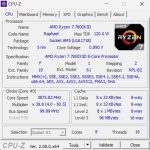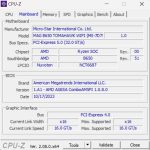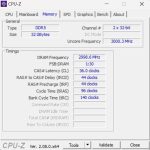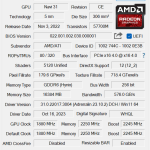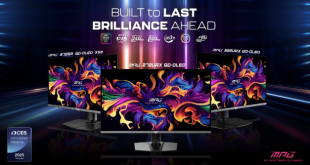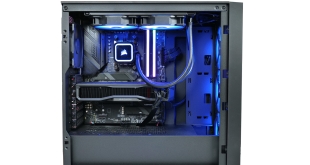
Today we are back with another prebuilt review, this time around we're checking out Cyberpower's Ultra R77 Pro. Packing in AMD's Ryzen 7 7800X3D processor, Radeon RX 7900 GRE graphics, plus 32GB DDR5 memory and a 2TB NVMe SSD, this system lands in upper-midrange territory. Priced at just below £1900 here in the UK, what sort of value is on offer? We take a close look at this system to find out.
Specification:
- Case: Corsair 3000D RGB Airflow Gaming Case – Black (features 3x ARGB 120mm fans)
- CPU (Processor): AMD Ryzen 7 7800X3D – 8-Core 4.20GHz, 5.00GHz Turbo – 96MB L3 Cache Processor w/ Radeon Graphics
- Graphics Card (GPU): AMD Radeon™ RX 7900 GRE – 16GB GDDR6 – HDMI, DP – RDNA™ 3 Architecture, Infinity Cache™ (Single Card)
- CPU Cooling: Corsair iCUE H100x RGB ELITE 240mm Liquid CPU Cooler, Ultimate OC Compatible
- Motherboard: MSI MAG B650 TOMAHAWK WIFI: ATX w/ Wi-Fi 6E, USB 3.2, 3x M.2
- Memory (RAM): 32GB (2x16GB) DDR5/6000MHz Corsair Vengeance RGB Memory
- PSU (Power Supply): MSI MAG A850GL PCIE5 850W 80+ Gold ATX 3.0 Fully Modular Gaming Power Supply
- NVME Drive: 2TB Kingston Fury Renegade M.2 PCIe 4.0 NVMe SSD – 7300MB/s Read & 7000MB/s Write (Single Drive)
- Wired Networking: ONBOARD 10/100/1000 GIGABIT LAN PORT — As standard on all PCs
- Sound Cards: HIGH DEFINITION ON-BOARD AUDIO
- Operating System: Windows 11 Home – with FREE trial of Microsoft 365 and 1 month Xbox Game Pass (64-bit Edition) (No Recovery Media)
- Warranty Service: DESKTOP GOLD WARRANTY: 5 Years' Labour, 2 Years' Parts, 2 Years' Collect and Return plus Life-Time Technical Support
Taking a closer look at the system, we start with the chassis, where Cyberpower has opted for the Corsair 3000D RGB Airflow. We've not reviewed this model but it is popular with system integrators, offering a compact mid-tower design. It's not a particularly feature-rich case but you get a mesh front panel, tempered glass side panel as well as three pre-installed 120mm RGB fans acting as intakes at the front. Cyberpower has added a plain black 120mm to the rear of the case, acting as an exhaust, while the two fans on the radiator are also exhausting out of the roof.
For the CPU itself, here we have the AMD Ryzen 7 7800X3D, which Leo reviewed earlier in the year. This is a fantastic all-round CPU, offering 8-core and 16-threads of Zen4 goodness, but crucially with that added 3D V-Cache which really shines when gaming, making this the fastest gaming CPU on the market right now. It's also relatively low-power, with a 120W TDP, and in the Ultra R77 Pro it is cooled by Corsair's H100x RGB Elite, a 240mm AIO with two 120mm RGB fans.
Cyberpower has paired that CPU with 32GB of Corsair Vengeance RGB memory, running at 6000 MT/s. Timings aren't the tightest, with a CL36 latency, and at the time of writing a CL30 kit only costs about £30 more than the CL36 kit, so that would have been a smart upgrade in my opinion. That said, we'd still expect the CL36 kit to perform fine and we can't argue with the capacity either.
As for the graphics horsepower, this is provided by AMD's RX 7900 GRE, a GPU we've not seen before. It was initially launched to just system integrators, but has just started to appear on the DIY market. It's essentially a RX 7900 XT but with 80 Compute Units, and only four active Memory Cache Dies, giving it 16GB VRAM and 64MB of Infinity Cache. In theory that means it should slot between the 7900 XT and the 7800 XT but we've got plenty of game benchmarks later in the review.
All of that hardware is plugged into the MSI MAGH B650 Tomahawk WiFi motherboard. We've not reviewed this one but I can't have any complaints about it from my experience, it looks solid and offered no issues during my testing. One thing worth noting is that this board doesn't support PCIe 5.0, either for M.2 drives or full-size PCIe slots, which isn't the end of the world but is unusual for a B650 motherboard, especially at this price. I also took a quick look into the BIOS as well where Cyberpower left most things on auto, but XMP and ReBar have been enabled. It's also good to see the system shipped to me with the absolute latest BIOS version installed, so fair play to Cyberpower for keeping on top of that area.
In terms of storage, Cyberpower has fitted a single M.2 drive in the primary slot just above the graphics card, underneath the integrated heatsink. The drive in question is a 2TB Kingston Fury Renegade which we reviewed earlier this year. It's a solid drive, and while it's Gen4 not Gen5, it's still going to be more than good enough for gaming. If you want to add more storage down the line, there is another Gen4 M.2 slot accessible below the graphics card which has its own heatsink too.
Switching to the back of the case, we can get a look at the power supply, MSI's MAG A850GL PCIe 5.0. We've not reviewed this one, on paper it looks fine offering 850W capacity and 80 Plus Gold certification. The ‘PCIe 5.0' part of the name just means it does support a 12VHPWR connector, which we don't need for the 7900 GRE, but the cable still comes included if you upgraded the GPU down the line.
It's hard to fault Cyberpower's cable management, too. Everything has been tied down and routed incredibly neatly, I certainly couldn't do better than this in a million years. It's just good to see how much care Cyberpower has given it, rather than just shoving everything behind the motherboard tray.
The final thing to mention is the RGB situation. Despite the RGB fans, liquid cooler and memory all being from Corsair, the cooler and fans actually plug directly into the motherboard with standard 5V ARGB headers. This means you can't use iCUE to control all the lighting, as only the memory shows up. You can supposedly use MSI Mystic Light to control Corsair's RGB memory, and it did show up for me, but no matter what I did the memory lighting never actually synchronised with the fans or liquid cooler. I guess it's not the end of the world but I don't think it's too much to ask to have all the RGB gear able to be controlled by a single piece of software.
 KitGuru KitGuru.net – Tech News | Hardware News | Hardware Reviews | IOS | Mobile | Gaming | Graphics Cards
KitGuru KitGuru.net – Tech News | Hardware News | Hardware Reviews | IOS | Mobile | Gaming | Graphics Cards














